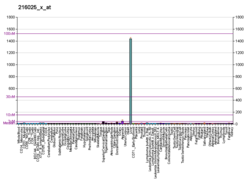
Back CYP2C9 Welsh Cytochrom P450 2C9 German CYP2C9 Spanish CYP2C9 Persian CYP2C9 Latin CYP2C9 Thai CYP2C9 Ukrainian CYP2C9 Chinese
Cytochrome P450 family 2 subfamily C member 9 (abbreviated CYP2C9) is an enzyme protein. The enzyme is involved in the metabolism, by oxidation, of both xenobiotics, including drugs, and endogenous compounds, including fatty acids. In humans, the protein is encoded by the CYP2C9 gene.[5][6] The gene is highly polymorphic, which affects the efficiency of the metabolism by the enzyme.[7]
- ^ a b c GRCh38: Ensembl release 89: ENSG00000138109 – Ensembl, May 2017
- ^ a b c GRCm38: Ensembl release 89: ENSMUSG00000067231 – Ensembl, May 2017
- ^ "Human PubMed Reference:". National Center for Biotechnology Information, U.S. National Library of Medicine.
- ^ "Mouse PubMed Reference:". National Center for Biotechnology Information, U.S. National Library of Medicine.
- ^ Romkes M, Faletto MB, Blaisdell JA, Raucy JL, Goldstein JA (April 1991). "Cloning and expression of complementary DNAs for multiple members of the human cytochrome P450IIC subfamily". Biochemistry. 30 (13): 3247–3255. doi:10.1021/bi00227a012. PMID 2009263.
- ^ Inoue K, Inazawa J, Suzuki Y, Shimada T, Yamazaki H, Guengerich FP, Abe T (September 1994). "Fluorescence in situ hybridization analysis of chromosomal localization of three human cytochrome P450 2C genes (CYP2C8, 2C9, and 2C10) at 10q24.1". The Japanese Journal of Human Genetics. 39 (3): 337–343. doi:10.1007/BF01874052. PMID 7841444.
- ^
 This article incorporates public domain material from "CYP2C9". National Center for Biotechnology Information, U.S. National Library of Medicine. National Center for Biotechnology Information. 29 March 2021.
This article incorporates public domain material from "CYP2C9". National Center for Biotechnology Information, U.S. National Library of Medicine. National Center for Biotechnology Information. 29 March 2021. This gene encodes a member of the cytochrome P450 superfamily of enzymes. The cytochrome P450 proteins are monooxygenases that catalyze many reactions involved in drug metabolism and synthesis of cholesterol, steroids, and other lipids. This protein localizes to the endoplasmic reticulum and its expression is induced by rifampin. The enzyme is known to metabolize many xenobiotics, including phenytoin, tolbutamide, ibuprofen, and S-warfarin. Studies identifying individuals who are poor metabolizers of phenytoin and tolbutamide suggest that this gene is polymorphic. The gene is located within a cluster of cytochrome P450 genes on chromosome 10q24.
 This article incorporates text from this source, which is in the public domain.
This article incorporates text from this source, which is in the public domain.







